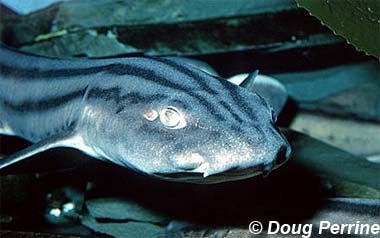
Poroderma africanum
This small nocturnal shark prefers the coastal waters off of southern Africa where it hunts crustaceans and small bony fish at night. It is gray with seven dark stripes that run from head to tail, and has gray lobed fins set further back toward the asymmetrical caudal fin than usual. For catsharks, these are one of the larger species, growing to almost 40 inches long at times, but they are still considered harmless to humans because of their size and habitat.
Order – Carcharhiniformes
Family – Scyliorhinidae
Genus – Poroderma
Species – africanum
Common Names
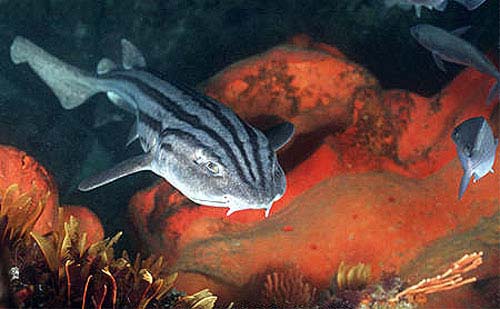
English language common names include striped catshark, pyjama shark, and striped cat shark. Other common names are alitán listado (Spanish), gestreepte kathaai (Dutch), l’endormi (French), mácka pyžamová (Czech), rekinek leniwy (Polish), roussette rubanée (French), streep-kathaai (Afrikaans), and stribet rødhaj (Danish).
Importance to Humans
The striped catshark is a hardy species, adapting well to life in captivity. Although it is often taken as bycatch by bottom trawlers, it is not used for human consumption, but instead usually discarded. This catshark is also sometimes fished recreationally. During the summer months, striped catsharks often congregate into shoals and easily hooked by recreational fishers who regard this species as a pest.
Danger to Humans
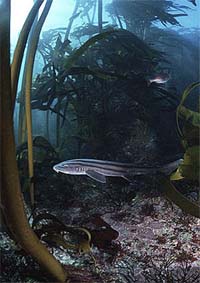
The striped catshark is considered harmless to humans due to its small size, habitat preference and feeding habits.
Conservation
This shark is currently listed by the World Conservation Union (IUCN) as “Lower Risk/Near Threatened”. The IUCN is a global union of states, governmental agencies, and non-governmental organizations in a partnership that assesses the conservation status of species.
> Check the status of the striped catshark at the IUCN website.
Having a limited distribution range and residing in shallow waters in heavily fished, highly populated area, the striped catshark has no specific protection. Even though this species is not specifically targeted by any fishery, it is subject to fisheries pressure from commercial and recreational fisheries. This is of increasing concern due to the recent development of commercial fisheries for small sharks for the export market.
Geographical Distribution
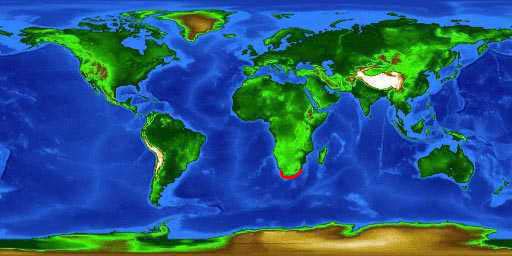
The striped catshark is endemic to waters off the coast of South Africa in the southeast Atlantic Ocean and western Indian Ocean. It is common in the waters of Cape Province off South Africa, especially the southern Cape. There are older records of this species from Madagascar and Mauritius, however these are unconfirmed.
Habitat
Occurring both inshore and offshore over the continental shelf, the striped catshark prefers rock reefs ranging from the intertidal zone to depths of 328 feet (100 m). As a nocturnal species, it is commonly observed in caves and crevices during the day. It is typically a very sluggish species during the day, with an increase in activity during the nighttime hours when it searches for prey.
Biology
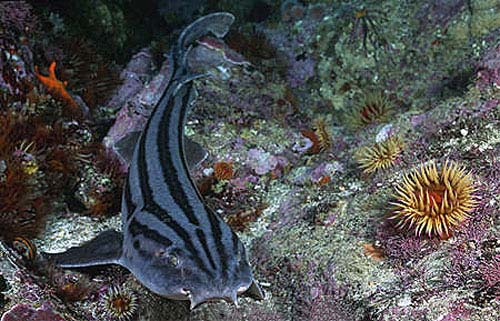
Distinctive Features
This is a large catshark with short nasal barbels measuring less than half the length of the nostrils. These barbells do not reach the mouth. There are two dorsal fins, the first of which is located opposite the midbase of the pelvic fins. The second dorsal fin is much smaller and terminates at the origin of the caudal fin. The pectoral fins are broad and rounded in shape.
Coloration
The striped catshark is grayish in color. There are seven distinct broad dark longitudinal stripes running the length of the body on the dorsal and lateral sides. One stripe runs down the back of the shark with three parallel stripes on either side of the body. These stripes become broken towards the tail and lower sides. The underside of the striped catshark is pale.
Dentition
Each jaw of this shark has several rows of sharp, thin tricuspid teeth. The mouth is broadly arched and moderately long, with the lower symphysis somewhat behind the upper exposing the upper teeth when viewed ventrally.
Size, Age, and Growth
Maximum size of male striped catsharks is 39.8 inches (101 cm) total length (TL) 36.6 inches (93 cm) TL for females. The average size of the adult striped catshark is 23.6-31.5 inches (60-80 cm) TL. Males reach maturity at lengths of 22.8-30.7 inches (58-78 cm) TL and females become mature at 25.6-28.3 inches (65-72 cm) TL. Hatchlings measure 5.5-5.9 inches (14-15 cm) upon emerging from the egg case.
Denticles
The thick skin of the striped catshark includes dermal denticles that are well calcified.
Food Habits
The striped catshark feeds primarily on crustaceans. Other prey items include small bony fish such as anchovy, gurnards, and hake. It also feeds cephalopods, mollusks, and polychaete worms.
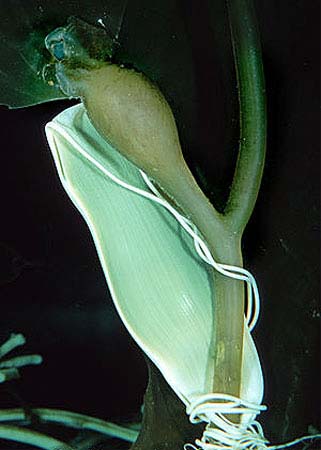
Reproduction
As an oviparous species, the striped catshark lays a single egg case per oviduct. Each season, the female releases two brownish, purse-shaped egg cases. Each egg case, measuring 2 x 4 inches (5 x 10 cm), has a sticky surface that adheres to kelp and other marine vegetation. In nature it is unknown how long after being released from the female it takes before hatching. However, an egg hatched after approximately 5 ½ months in an aquarium. The hatchlings measure about 5.5-5.9 inches (14-15 cm) in length and closely resemble the adult striped catshark.
Predators
Predators of the striped catshark include larger sharks such as the sevengill shark (Notorynchus cepedianus).
Taxonomy
The striped catshark was originally described by Gmelin in 1789 as Squalus africanus. This name was later changed to the currently valid scientific name, Poroderma africanum (Gmelin 1789). Synonyms include Squalus vittatus Shaw and Nodder 1798 and Squalus striatus Lichtenstein 1844. The genus name Poroderma refers to “skin with pores” while the species name africanum refers to “from Africa”.
Prepared by: Cathleen Bester